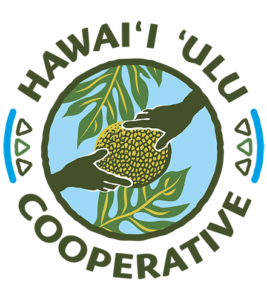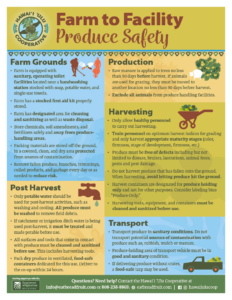‘Ulu Farm to Facility Produce Safety
Learn about safety from the farm to the market
Do you have a proper hand-washing station, or a first-aid kit close by on your farm? Check out this flyer on Farm to Facility Produce Safety and learn more about best practices when it comes to ensuring the safety of your crop and employees. This includes harvesting, post-harvest practices, and transport-related standards. Download the flyer below and get familiar with best safety practices for your farm!
Download the guide (PDF) to learn more about the best safety practices. Also check out our new blog post on Farm Produce Safety Here giving details on coverages and exemptions related to federal requirements under the Farm Produce Safety Rule.
Farm Grounds
• Farm is equipped with sanitary, operating toilet facilities located near a handwashing station stocked with soap, potable water, and single-use paper towels.
• Farm has a stocked first aid kit properly stored.
• Farm has a designated area for cleaning and sanitizing as well as waste disposal
• Store chemicals, soil amendments, and fertilizers safely and away from produce-handling areas.
• Packing materials are stored off the ground in a covered, clean, and dry area protected from sources of contamination.
• Remove fallen produce, branches, trimmings, culled products, and garbage every day or as needed to reduce risk
Production
• Raw manure is applied to trees no less than 90 days before harvest. If animals are used for grazing they must be moved to another location no less than 90 days before harvest.
• Exclude all animals from produce handling facilities.
Harvesting
• Only allow healthy personnel to carry out harvesting
• Train personnel on optimum harvest indices for grading and only harvest appropriate maturity stages (color, firmness, stage of development, etc)
• Produce must be free of defects including but not limited to disease, bruises, lacerations, animal feces, pests and pest damage.
• Do not harvest fruit that has fallen onto the ground. When harvesting, avoid letting produce hitting the ground.
• Harvest containers are designated for produce holding only and not for other purposes. Consider labeling bins “Produce Only”.
• Harvesting tools, equipment, and containers must be cleaned and sanitized before use.
Post Harvest
• Only potable water should be used for post-harvest activities, such as washing and cooling. All produce must be washed to remove field debris.
• If catchment or irrigation ditch water is being used post-harvest, it must be treated and made potable before use.
• All surfaces and tools that come in contact with produce must be cleaned and sanitized before use.
• Pack dry produce in ventilated, food-safe containers dedicated for this use. Deliver to the co-op within 24 hours
Transport
• Transport produce in sanitary conditions. Do not transport potential sources of contamination with produce such as rubbish, mulch, or manure.
• Produce-holding area of transport vehicle must be in food and sanitary condition.
• If delivering produce without crates, a food-safe tarp may be used.

